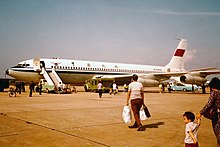1990 Guangzhou Baiyun airport collisions
Shanghai Hongqiao Airport | |
| Occupants | 122 |
|---|---|
| Passengers | 110 |
| Crew | 12 |
| Fatalities | 46 |
| Injuries | 34 |
| Survivors | 76 |
| Third aircraft | |
 B-2402, the China Southwest Airlines Boeing 707 involved in the collisions, taken in 1983 | |
| Type | Boeing 707-3J6B |
| Operator | China Southwest Airlines |
| IATA flight No. | SZ4305 |
| ICAO flight No. | CXN4305 |
| Call sign | CHINA SOUTHWEST 4305 |
| Registration | B-2402 |
| Flight origin | Chengdu Shuangliu Airport |
| Destination | Former Guangzhou Baiyun International Airport |
| Occupants | 1 |
| Passengers | 0 |
| Crew | 1 |
| Fatalities | 0 |
| Injuries | 1 |
| Survivors | 1 |
On 2 October 1990, a hijacked Boeing 737, operating Xiamen Airlines Flight 8301, collided with two other aircraft on the runways of the old Guangzhou Baiyun International Airport while attempting to land. The hijacked aircraft struck parked China Southwest Airlines Flight 4305 first, inflicting only minor damage, but then collided with China Southern Airlines Flight 3523, a Boeing 757 waiting to take off, flipping onto its back. A total of 128 people were killed, including seven of nine crew members and 75 of 93 passengers on Flight 8301 and 46 of 110 passengers on Flight 3523.
Hijacking of Flight 8301
Prior to the hijacking and shortly after the aircraft took off from
Communication with the flight was lost. It was finally re-established by the airport in Guangzhou, which authorized the pilot to land at any airport available, inside or outside the PRC. The pilot stated that the only other airport that the aircraft still had sufficient fuel to reach was Hong Kong. Guangzhou flight controllers agreed to allow the plane to land in Hong Kong, refuel, and proceed to Taipei. Jiang refused to allow this, and threatened to blow up the aircraft if it landed in Hong Kong. The pilot circled Guangzhou, attempting to reason with Jiang. He was eventually forced to land the plane when it ran dangerously low on fuel.[2]
Landing and collisions
Moments before landing, Jiang managed to wrestle control of the aircraft from the pilot. The 737 landed at an excessive speed, and sideswiped a parked China Southwest Airlines
On the Xiamen Airlines 737, seven of the nine crew members and 75 (including 30 Taiwanese, three people from Hong Kong and one American) of the 93 passengers died.[1] On the China Southern 757 aircraft all 12 crew members survived and 46 of 110 passengers died.[8] Of the passengers who died in the 757, eight were from Taiwan.[10] A total of 128 people died in the disaster,[5] including Jiang, the hijacker of the Xiamen Airlines aircraft.[4]
The hijacker
Jiang was once arrested for theft in September 1988. While working as a purchasing agent in 1990, he fled on 13 July with RMB 17,000 which was given to him for purchasing goods for his company. He was wanted by the police at the time of the hijacking.[3]
Two months earlier, on 29 September, Jiang checked-in at a hotel near the Xiamen borders. The next day, he booked a seat on the flight he would go on to hijack. Jiang checked out of the hotel around 6 a.m. on the morning of 2 October and headed to the airport. He was seen wearing a black suit and black dress shoes, carrying a black suitcase, and holding plastic roses. Jiang was the last to board the plane. He was sitting at seat 16D.[11]
See also
References
- ^ Aviation Safety Network
- ^ a b c "Lessons Learned from Hijacking" (PDF). Flight Safety Digest. Flight Safety Foundation. December 1990. p. 13. Archived from the original (PDF) on 16 June 2013. Retrieved 23 November 2012.
- ^ a b 周益 朱林 (2009-06-12). 白云机场"10·2"特大空难揭秘 ["10·2" Extraordinary Air Accident at Baiyun Airport Revealed]. 周末 (in Chinese). Archived from the original on 2014-02-22. Retrieved 2011-06-12.
- ^ TIME. 15 October 1990. Archived from the originalon October 23, 2012. Retrieved 24 November 2009.
- ^ from the original on 2 January 2014. Retrieved November 24, 2009.
- Aviation Safety Network
- ^ "广州10.2空难回顾" [Guangzhou 10.2 air crash review] (in Chinese). Guangzhou Daily. 2015-02-04. Archived from the original on 2019-02-04. Retrieved 2019-07-19.
- ^ Aviation Safety Network
- from the original on 14 August 2018. Retrieved 24 November 2009.
- ^ FCJ Editors. "Relatives Bring Ashes Home In Sorrow, Anger" (Archive). Taiwan Journal. 15 October 1990. [dead link]
- ^ "1990年厦航客机空难揭秘 客机遭劫撞毁空姐玉殒" [The secret of the 1990 Xiamen Airlines passenger plane crash revealed. The passenger plane was hijacked and crashed and the flight attendant Yu died]. www.fjsen.com (in Chinese). 2009-06-08. Archived from the original on 2014-08-31. Retrieved 2021-06-17.
External links
- Flight Safety Foundation's Flight Safety Digest, December 1990—a brief about the incident is on Pages 13–14 (Archive)
